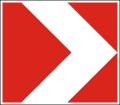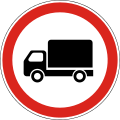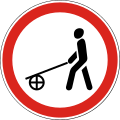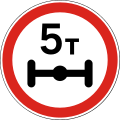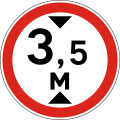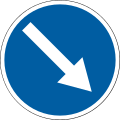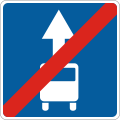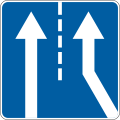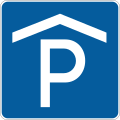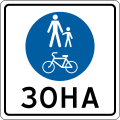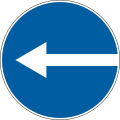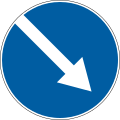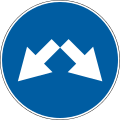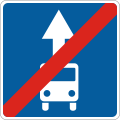There are images of historic or obsolete road signs, some of them are no longer used. However, the Soviet-style road signs and the typeface specified in the Soviet GOST 10807-78 standard may still be used in inscriptions despite the fact that the modern DSTU 4100:2021 is adopted.
Steep climb (1991–2021)
Steep descent (1991–2021)
No vehicles over 7 tonnes (1991–2021)
No vehicles over 5 tonnes per axle (1991–2014)
No vehicles wider than 2.7 meters (1991–2021)
No vehicles higher than 3.5 meters (1991–2021)
No vehicles longer than 10 meters (1991–2021)
Drivers must maintain a distance of at least 70 meters (1991–2021)
Speed limit (1991–2021)
Speed limit zone (1991–2021)
End of speed limit zone (limit reverts to default for road class) (1991–2021)
No parking zone (1991–2021)
End of no parking zone (1991–2021)
Proceed straight only (1991–2021)
Turn right only (1991–2014)
Turn left only (1991–2014)
Proceed straight or turn right (1991–2021)
Proceed straight or turn left (1991–2021)
Turn left or right (no straight ahead) (1991–2021)
Keep right (1991–2021)
Keep left (1991–2021)
Keep right or left (1991–2021)
Roundabout (1991–2021)
Pedestrian path (1991–2021)
Minimum speed limit (1991–2021)
End of minimum speed limit (1991–2021)
Motorway begins (1991–2021)
Motorway ends (1991–2021)
U-turn zone (1991–2021)
Advisory speed (1991–2021)
Stop (used where a regular stop sign is not needed, such as unprotected railway crossings) (1991–2021)
Stop for other control (1994–2021)
Stop for dangers, including traffic accidents, natural disasters or other road obstructions (1994–2021)
Lane for buses begins (1994–2021)
Lane for buses ends (1994–2021)
Additional lane on the right begins with minimum speed limit for left lane (1994–2021)
Emergency escape lane for runaway vehicles (1994–2021)
Pedestrian zone (1994–2014)
Pedestrian zone ends (1994–2014)
Parking zone (1994–2021)
Parking zone ends (1994–2021)
Settlement begins (1994–2021)
Settlement ends (1994–2021)
Village begins (1994–2021)
Village ends (1994–2021)
National speed limits (used at border crossings with other countries) (1994–2021)
Other road restrictions (such as for a mountainous road ahead) (1994–2021)
Route guide sign with destinations (1994–2021)
Route guide sign with destinations (1994–2021)
Route guide sign with destinations (1994–2021)
Alternative route to meet your destination where left turn is prohibited (1994–2021)
Detour route on straight (1994–2014)
Detour route on right (1994–2014)
Detour route on left (1994–2014)
Street name sign (1994–2021)
River name sign (1994–2021)
Destinations sign with distances (1994–2021)
Road distance interval marker (1994–2021)
Road route number sign (1994–2014)
Road route number sign (1994–2014)
First point of medical care (1994–2021)
Hospital (1994–2021)
Emergency phone call (1994–2021)
Traffic police (1994–2021)
Rest homes (1994–2021)
Pedestrian hitch-hiking route (1994–2021)
Above sign enters force on date (1994–2002)
Route guide sign with destinations (2002–2014)
Route guide sign with destinations (2002–2014)
Route guide sign with destinations (2002–2021)
Route guide sign with destinations (2002–2014)
Route guide sign with destinations (2002–2014)
Alternative route for closed road (2002–2014)
Road number and direction sign (2002–2014)
Road number and direction sign (2002–2014)
Fire extinguisher (2002–2014)
Above sign enters force on date (2002–2021)
No vehicles over 5 tonnes per axle (2014–2021)
End of speed limit (limit reverts to default for road class) (2014–2021)
Turn right only (2014–2021)
Turn left only (2014–2021)
Park and ride (2014–2021)
Route guide sign with destinations (2014–2021)
Route guide sign with destinations (2014–2021)
Route guide sign with destinations (2014–2021)
Route guide sign with destinations (2014–2021)
Route guide sign with destinations (2014–2021)
Route guide sign with destinations (2014–2021)
Route guide sign with destinations (2014–2021)
Route guide sign with destinations (2014–2021)
Route guide sign with destinations (2014–2021)
Alternative route for closed road (2014–2021)
Detour route on straight (2014–2021)
Detour route on right (2014–2021)
Detour route on left (2014–2021)
Destinations sign with distances (2014–2021)
Church (may include name or religious denomination) (2014–2021)
Factory (2014–2021)
New road signs ahead (2014–2021)
Above sign applies to vehicles carrying dangerous goods (2014–2021)
Green wave (2020–2021)







